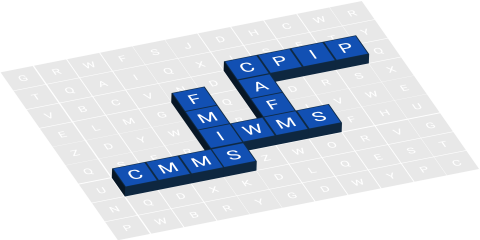
Quite new to Planon in my role as senior Solution Marketer, I was asked to update the ‘What is IWMS?’ white paper. A good first introduction for me to become familiar with what an Integrated Workplace Management System (IWMS) entails, who it is intended for, and what value and benefits it provides for customers. This is how I found out that in the United States and within global organisations, IWMS is a well-known and accepted term. However, in the United Kingdom and other parts of Europe, software for real estate and facility management is often referred to as Computer Aided Facility Management (CAFM) and in the Netherlands and Belgium often as Facility Management Information System (FMIS). In 2022, Verdantix added Connected Portfolio Intelligence Platform (CPIP) to the mix. Time for me to do a deep-dive into similarities and differences , give some historical background and put your mind at ease.
From a functional perspective, the main difference between IWMS and CAFM is that IWMS also includes extensive functionality for property and lease management, project management and environmental sustainability. In addition to IWMS and CAFM, which focus on supporting a combination of integrated processes, there are many specialised solutions. These solutions focus on one process or a specific set of processes, mostly related to one main topic.
In a recent Market Insight report, Verdantix states that IWMS solutions are now evolving into Connected Portfolio Intelligence Platforms (CPIPs), providing greater customer value through insights derived from IoT and advanced analytics. Before I give my take on the matter, let’s take a trip down memory lane to get a better understanding of what I’m talking about.
The Integrated Workplace Management System (IWMS): A brief history
IWMS 1.0
From the 1980s up until the 2000s, organisations supported their facility management processes with specialised solutions and CAFM solutions. These solutions often worked well for managing single buildings, or a simple portfolio, and were usually designed to perform a single function at a time. Maintenance management, facilities management, and asset tracking were the main functions involved.
In the early 2000s IWMS emerged and offered a more comprehensive approach to facilities management. IWMS solutions allowed data relating to a complex portfolio of buildings to be centralised in one place. Functionality expanded to cover lease management, space management, and energy reporting.
The basic data warehousing and business reporting capabilities of CAFM solutions was updated too. With IWMS, data mining, business intelligence, and data visualisation became possible.
IWMS solutions could also be integrated with business software solutions and Building Information Modelling (BIM), benefiting a wide range of stakeholders such as finance and corporate real estate planners, in addition to facilities managers.

IWMS 2.0
Between 2010 and 2022, due to various technology-related and customer-driven trends, IWMS evolved significantly. Having an IWMS in place was acknowledged as an important factor, in relation to the quality of the workplace experience. IWMS went beyond simply managing the facility and was used to also manage the experience of building users. It was used to manage service delivery in addition to the physical elements of the space and assets.
From a technological perspective, as the world transitioned to mobile and the cloud, IWMS 2.0 became cloud-based, modularised, mobile-ready, and capable of integrating relevant IoT data. Suppliers also improved data analytics with the application of artificial intelligence (AI) and machine learning (ML). In addition, solutions became easier for non-technical staff to customise through low-code approaches.
These transformations were further encouraged by the switch to hybrid workplace strategies, which increased demand for more agile IWMS solutions. Organisations’ demand for these solutions for managing employee health and safety sky-rocketed due to COVID-19. These developments were adding to the need for more customisable and modular offerings.
Exploring the evolution of IWMS and Connected Portfolio Intelligence Platforms (CPIP)
It has been a time of immense change and innovation, with the emergence of new technologies such as cloud-connected IoT devices and digital twins, and the pressure of energy crises driving facility optimisation. Moreover, the rise-and-rise of the PropTech market leading to continued investment, has driven solutions from being hardware-focused to being software- and eventually service-driven. Concurrently, a revolution in user behaviour has been brought on by a broad-based push towards making the industry more accountable for ESG and more occupant-experience-oriented – as well as, of course, the impact of COVID-19.
IWMS suppliers have so far responded admirably to these trends, and successfully fulfilled ever-changing customer needs. The question now arises whether the current iteration of IWMS has reached its limit, and if connected portfolio intelligence platforms (CPIP) are better placed to serve customer demands moving forward. Smart building platforms like CPIP present a more open architecture, enhancing their interconnectivity with smart buildings and their ecosystems. According to Verdantix, these platforms tackle the following challenges:
- By incorporating third-party point solutions, customers will also be able to leverage CPIPs to tackle emerging challenges such as sustainability management and ESG.
- By making all relevant data accessible at the point of need, CPIPs will overcome the platform versus point-solution argument.
- CPIP customers will also be able to gain new insights and create smarter workflows, by utilising granular IoT data sets.
- It will be possible to gather data from operational technology such as BMS and BAS using CPIPs to create smart buildings.
- With CPIPs, software maintenance will be simplified through modular, cloud-based, out-of-the-box workflows. Helping to reduce time-to-value-related issues.
- As the user base for these platforms continues to expand - with HR executives, financial directors, sustainability professionals and others requiring access - CPIPs will provide tailored apps and dashboards for each user group.
You can find a comprehensive summary of the fundamental features of CPIPs in the table below:
Fundamental Features Of CPIP Offerings*
| Feature | Requirements |
|---|---|
| Core Value Proposition | Employee engagement and workflow optimization across the hybrid workplace. Asset performance improvements enabled by real-time data and advanced analytics |
| Modules | Facilities, maintenance, lease, property, capital projects, space, workplace, employee experience, asset and energy/ESG management |
| Product Architecture | Cloud-first architecture with targeted integrations; IoT data-capture capabilities and low-code offering |
| Analytics | Advanced analytics: AI, ML, RPA |
| Data Input | Manual, smart devices (e.g. IoT sensors and meters, and connected equipment), building systems (e.g. HVAC and BMS), and third-party software and existing business solutions (e.g. ERP) |
| User Experience | Integrated omnichannel user experience: single dashboard for reporting, and consistent UI across modules and devices |
| Assets Managed | Buildings and non-building assets (e.g. linear assets), and employees’ homes |
| User Types | FM, HR, RE, FD, sustainability and building users |
* Market Insight Verdantix (2022): The Transformation Of IWMS To Connected Portfolio Intelligence Platforms (CPIP)
You can put your mind at ease
Looking at how Planon is currently positioned as the leading provider of smart and sustainable building management software, I would argue that Planon’s software covers the load and is future-proof. Our open platform ticks all the boxes when I look at the definition Verdantix offers of CPIP ‘Cloud-connected platforms that help firms enhance the performance of buildings across portfolio management, operations and employee experience’. So let me be the one who sets your mind at ease. It doesn’t matter if you are looking for an IWMS, CAFM, CMMS, CPIP, etc; with Planon’s smart and sustainable building management software all bases are covered.
